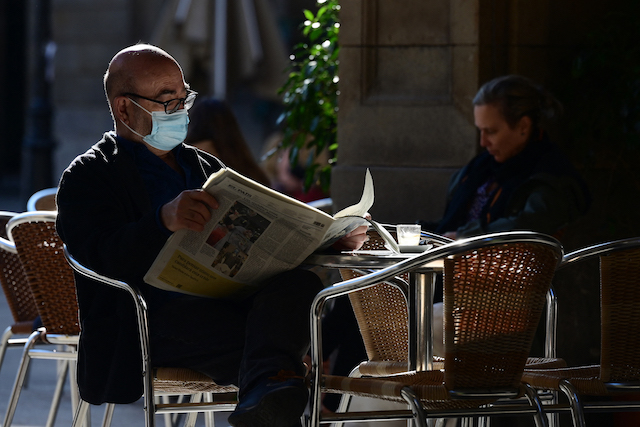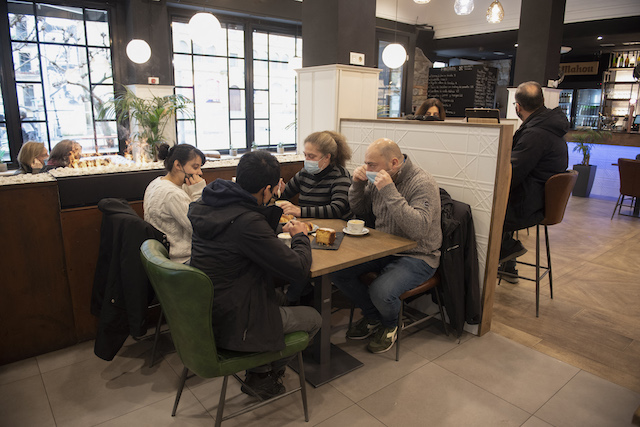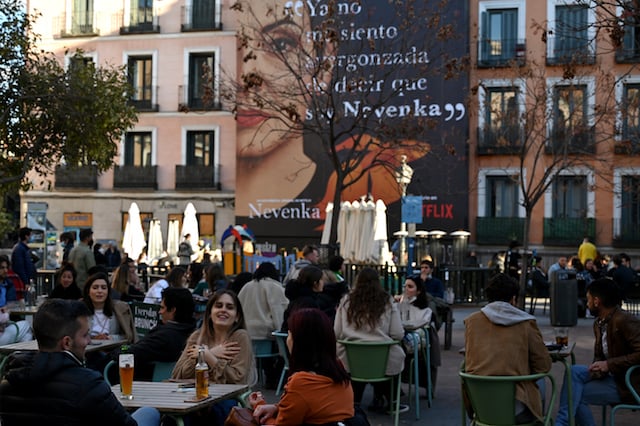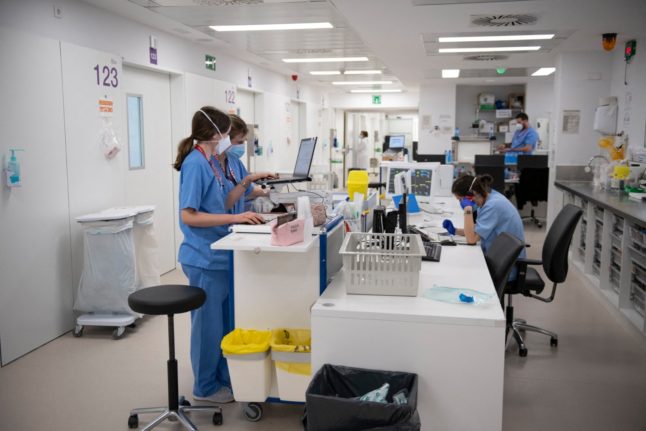****For an updated version with Spain’s regional Covid restrictions in August 2021, click here.
Madrid
Starting from Friday June 4th, the terraces of Madrid’s bars and restaurants will only be allowed to open until midnight instead of 1am.
- The border closure around the region is lifted and no health zones are confined
- There are no official restrictions on how many people can meet, but the regional government is recommending limitations.
- Bars and restaurants can operate at 50 percent capacity indoors and 75 percent on the terraces.
- Bar service remains closed
- Four six can sit at tables indoors and eight outdoors
- Cultural venues such as cinemas and theatres can open until 1am with a capacity of 75 percent
- Gyms are reduced to 50 percent capacity and can operate from 6am to midnight.
Valencia region
From June 8th, new rules will come into force in the Valencia region. This means that from this date the curfew will be lifted and there will be no restrictions on the number of people who can meet. Nightlife will be able to open to 2am and bars and restaurants to 1am with a capacity of 50 percent indoors and no limitations on the terraces.
Until June 8th, the current restrictions are:
- The borders of Valencia are open
- The curfew between 1am until 6am is still in place
- Bars and restaurants can stay open until 12.30am. There will be a 50 percent capacity limit indoors, but 100 percent capacity on the terraces.
- Up to 10 people can sit at a table
- Up to 10 people can also meet both in private and in public
Catalonia
New measures will come into force in Catalonia on June 4th. These will include allowing the bars and restaurants to stay open until 1am. Current rules include:
- The borders of the region are open
- The curfew is no longer in place
- Social gatherings are limited to ten people, unless they live in the same household
- The interior of bars and restaurants can open to 50 percent capacity
- Up to six people are allowed at a table
- Picnics are now allowed again
- Shops can open until 10pm at 50 percent capacity
- Civil ceremonies cannot surpass 1,000 attendees outdoors
Andalusia
The easing of restrictions in Andalusia will happen in three phases. The second phase will last until June 21st and then after June 21st they hope to introduce a normalisation phase.
- The borders of the region are open
- The curfew has been lifted
- Bars and restaurants will be allowed to open until midnight. The interiors can operate at 75 percent and the terrazas at 100 percent. In those areas at level three, bars and restaurants must reduce interior capacity to 50 percent.
- Eight people are allowed per table inside and 10 people per table outside
- Any municipality with over 5,000 inhabitants with a Covid-19 incidence greater than 1,000 will still have to close its borders. In these areas, only essential shops will be allowed to open.
- Bars with music and nightclubs will be allowed to open until 2am, but only outdoor dance floors will be allowed to be used. Masks must be worn at all times.
- Celebrations can now happen with 50 to 300 people indoors and 75 to 500 people outdoors depending on the level.

Balearic Islands
The Balearics supreme court recently rejected the proposal to keep a curfew in place and has also rejected limiting social gatherings. This means both the curfew and limits on social gatherings ended on June 3rd.
From Sunday, June 6th, large commercial stores will be able to re-open and the interiors of bars and restaurants will also be able to reopen until midnight at a 50 percent capacity. This means all islands will go to level 1.
- If people enter the Balearics from other regions in Spain or if they have left the Balearics for more than 72 hours, they still need a negative PCR or antigen test.
- From June 6th bars and restaurants can operate at 50 percent capacity inside and 100 percent outside and are allowed to open until midnight.
- The limit will be four per table inside and eight outside.
- Cultural venues can operate at 50 percent, except in Menorca where it’s 40 percent
- Beaches have opening hours running from 7am until 9pm
Canary Islands
The Canary Islands currently have open regional borders and no curfew in place. Travellers must still present a negative PCR or antigen test upon arrival. The following measures will stay in place until at least July 31st.
The islands are still following the traffic light system they did before the state of alarm ended. Currently, Fuerteventura, El Hierro, La Palma and La Gomera and Gran Canaria are on level 1 and Tenerife and Lanzarote are on level 2.
Level 1:
- No limits on entering or leaving the island
- Social gatherings limited to ten people maximum
- Restaurants/bars close at midnight
- Ten people allowed per table on the terraces and six in the interiors
Level 2:
- No limits on entering or leaving the island
- Social gatherings limited to six people maximum
- Restaurants/bars close at midnight
- Terraces can open to 75 percent capacity and interiors to 50 percent. Six are allowed per table outside and four inside.
Level 3:
- Entering and leaving the island is restricted to those with justified cause (work, study, legal or administrative appointments, to care for dependents or to return to habitual or familial home). Travel between islands is only allowed for essential reasons.
- Social gatherings limited to four people maximum
- Restaurants/bars close at 10. Only outside table service with 50 percent capacity
- Sports centres closed inside and outside only allow groups of up to four, public transport functioning with 50 percent capacity but all markets and cultural events suspended.
Murcia
- Regional borders are open
- No curfew, but non-essential businesses will close between midnight and 6am
- Six people can meet in private and in public, but there is no limit if the people live together.
- The terraces of bars and restaurants can operate at 100 percent while the interiors of those municipalities in levels 1 and 2 can operate at 50 percent. Those in level 3 will only be allowed to open interiors up to 30 percent capacity.
- Bars and restaurants have to close by 1am
- Six people can sit at tables and outdoors and four indoors
- Weddings and communions are allowed to take place with a maximum of 50 people indoors and 100 outdoors.
- Municipalities or localities that exceed 250 cases per 100,000 inhabitants will be confined.
Basque Country
From June 2nd, the Basque Country allowed bars and restaurants to open until midnight.
- Regional borders are open
- There is no curfew in place
- Bars and restaurants can stay open until midnight but they are capped at 50 percent capacity indoors
- Four people can sit at a table and consuming anything at the bar is not allowed.
Galicia
- The curfew has been lifted, except for in regions in the “extreme” risk category
- Regional borders are open but the borders of any areas within Galicia at a high-risk level will stay closed.
- Up to 10 people can meet outdoors and six can meet indoors, including in people’s homes.
- However, those in the same household cannot meet inside from 1am-6am
- Bars and restaurants can stay open until 1am. In areas on high alert the interiors have to close and the terraces can open to 50 percent capacity. In areas of medium alert interiors can open to 30 percent and terraces to 50 percent, and in areas of low alert interiors can open to 50 percent and exteriors to 75 percent.

Castilla y León
As of Friday June 4th, all provinces on high alert level 3 will move to level 2 medium alert. The capacity of bars and restaurants will remain the same, but eating at the bar will be allowed and up to 10 will be able to sit at a table, instead of six.
Current restrictions are:
- Regional borders are open
- Curfew has been lifted
- The limitation on family and social gatherings has been lifted
- 50 percent capacity in shops
- Bars and restaurants will be allowed to open until 1am for terraces and midnight for indoors, however, the interiors will have to close in those municipalities with a 14-day cumulative infection rate of 150 Covid-19 cases per 100,000 inhabitants. Indoor customers must remain at their table, they can’t be served at the bar or eat or drink standing up.
- 1/3 capacity inside restaurants with a maximum of six per table and 75 percent capacity on the terraces, also with a maximum of six per table.
- 75 percent capacity for weddings, baptisms, communions and funerals, but 100 percent capacity if they are celebrated in churches.
Castilla La Mancha
- Regional borders are open
- The curfew has been lifted
- Bars and restaurants are allowed to stay open until 1am with 75 percent capacity inside and 100 percent on the terraces.
- 10 people will be able to meet at a time. This number can also sit at restaurant tables both indoors and outdoors.
- Shops is low risk level 1 and 2 areas can open to 75 percent capacity, those in level 3 areas can open to 50 percent capacity (with smaller shops allowed 60 percent capacity). Shops in reinforced level 3 areas must close.
- Cultural venues, libraries and swimming pools can also open to 75 percent capacity.
Asturias
- Regional borders are open
- No curfew
- Restaurants can stay open until 1am, apart from in municipalities that are confined.
- Up to six people per table are allowed to sit indoors and on the terraces
- The borders of localities and neighbourhoods will still close if the incidence rate goes over 325 cases per 100,000 for three consecutive days.
- There are no limits on the number of people who can meet indoors in private homes or outdoors.
- Swimming pools can open to 50 percent capacity
- Universities have suspended face-to-face classes until the end of the academic year.
Cantabria
The Cantabrian courts have overturned the decision of the regional government to establish a closing time for bars and restaurants of 1am.
- No curfew
- Regional borders are open
- Bars and restaurants in level 1 areas can open to 50 percent capacity indoors with 10 per table on the terraces and six inside. Those in level 2 can open to 33 percent capacity indoors and 75 percent capacity outdoors with six per table. Those in level 3 must close the interiors, but can open terraces to 75 percent with six per table.
- Masks must be used on restaurant terraces when not eating or drinking and smoking is prohibited.
- There is no limit on the number of people that can meet
- Shops in level 1 can open to 75 percent capacity, in level 2 to 50 percent, and in level 3 to 33 percent.
- Cultural venues can open to 75 percent capacity in areas in levels 1 and 2 and 50 percent in level 3.
La Rioja
- No curfew and no closure of the regional border
- In areas at level 1 bars and restaurants can open their interiors to 75 percent and the terraces to 100 percent, there is no enforced closing time. Those in areas in level 2 have the same capacity limits, but must close by 1am. Those in level 3 can open their interiors to 50 percent, but there is no limit on the terraces. They must close by midnight.
- Areas in level 1 have no restrictions on shops. Areas in levels 2 and 3 can open shops to 75 percent capacity.
- However, municipalities at level 3+, will be given more restrictive measures given their epidemiological situation.
- It’s recommended that no more than six people meet both indoors and outdoors.
Navarra
From June 4th the Navarran government has announced further relaxation to restrictions.
- Regional borders are open
- There is no curfew.
- Bars and restaurants have been given two options in Navarra. They can open their interiors to 30 percent capacity with tables two metres apart, or have no limit on capacity, but have two metres between chairs, air quality control machines and a fast way of contacting clients who have eaten there.
- The interiors of bars and restaurants must close by 11pm and the terraces must close by 1am.
- Large and medium shops can open to 50 percent capacity, with smaller shops can open to 60 percent capacity. They must close by 10pm.
- Up to 8 people from 3 different households can meet at a time both in private and in public.
Extremadura
- There is no curfew, but non-essential activities must still stop by midnight.
- Borders are open
- The interiors of bars and restaurants can open to 50 percent with six per table. 85 percent capacity on the terraces. They must close by 1am.
- Shops will be limited to 75 percent capacity. Large department stores can open to 40 percent capacity.
- Cultural venues can open to 50 percent capacity
Aragón
From June 4th Aragón is lifting the border closures on those municipalities that have been confined. This means that people will be able to move freely across the whole region.
- Regional borders are open
- No curfew
- The regional government is still able to impose a lockdown in municipalities or localities with high numbers of cases.
- Bars and restaurants in level 2 areas can open their interiors to 50 percent capacity and their exteriors to 100 percent with five per table inside and six outside. They must close by midnight. Those in level 3 can open to 30 percent capacity inside and 100 percent capacity outside with six per table. They must close by 11pm.
- Large stores in level 2 areas can operate at 50 percent capacity and in level 3 to 25 percent capacity.
- All cultural festivals have been suspended until August 31st



 Please whitelist us to continue reading.
Please whitelist us to continue reading.
Member comments